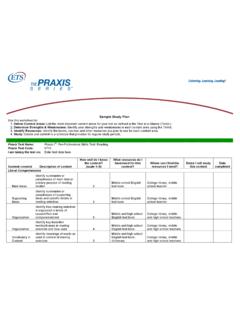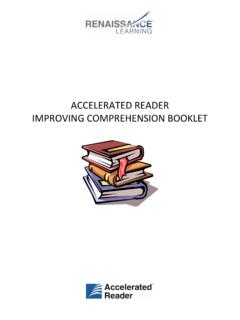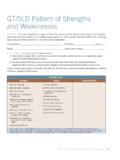Transcription of GCSE ENGLISH LANGUAGE - filestore.aqa.org.uk
1 GCSE ENGLISH LANGUAGET eaching synthesisFurther insight series AQA Education (AQA) is a registered charity (number 1073334) and a company limited by guarantee registered in England and Wales (number 3644723). Our registered address is AQA, Devas Street, Manchester M15 6EX. A ten point plan for teaching synthesis GCSE ENGLISH LANGUAGE (8700) Further insights series: The assessment of synthesis on GCSE ENGLISH LANGUAGE Paper 2 Question 2 Aims To explain the Assessment Objective (AO) and constituent parts of the question. To provide one example of a possible methodology to help students to develop the skills required. This resource should be read in conjunction with: specimen papers and mark schemes, available on Secure Key Materials resources and slides used at Preparing to teach meetings.
2 By way of reassurance, whilst synthesis is a new skill to be assessed at GCSE, early indications from pilot schools are that it is a relatively straight-forward comprehension task. This resource provides, as part of its explanation, some ideas for teaching and learning. These are shared in the spirit of stimulating professional development and thinking. It should not be seen as an authorised approach, or the only approach that students can take to responding successfully to this question. GCSE ENGLISH LANGUAGE AOs SYMMETRY GRID Paper 1 Q1 Q2 Q3 Q4 Q5: Writing AO1 List 4 Identify explicit information Identify explicit ideas AO2 How does the writer suse of Explain, comment on, analyse AO2 How does the writer Explain, comment on, analyse AO4 To what extent doyou agree?
3 Evaluate texts critically AO5/AO6 Descriptive or narrative writing Communicate clearly Organise information Use a range of vocab and sentences Accurate spelling and punctuation 4 marks 8 marks 8 marks 20 marks 40 marks Paper 2 AO1 Identify and interpret explicit and implicit information and ideas AO1 Write a Synthesis of explicit and implicit ideas and information AO2 How does the writer suse of Explain, comment on, analyse AO3 How the writers Compare writers ideas and perspectives, and how they are conveyed AO5/AO6 Students write about their own views As above 4 marks 8 marks 12 marks 16 marks 40 marks Assessment journey: Two equal demand papers which balance progression through the papers.
4 Reading AO1: P1 Q1 begins with explicit retrieval. This is mirrored in P2 Q1 through true/false statements and culminates in a summary task of both implicit and explicit reference as a pointer to P2 Q4. Reading AO2: P1 Q2 provides a specific example for analysis. P2 Q3 requires students to select examples of their own. Reading AO4/3: Evaluation of a section of text on P1 Q4 leads to comparison of two whole texts in P2 Q4. Writing AO5/6: P1 reading source acts as stimulus for descriptive, and or narrative writing. P2 reading sources support students to write their own views. 6 AQA Education (AQA) is a registered charity (number 1073334) and a company limited by guarantee registered in England and Wales (number 3644723).
5 Our registered address is AQA, Devas Street, Manchester M15 6EX. 2 of 7 1. What is the question assessing? The question only assesses AO1 which requires students to: identify and interpret explicit and implicit information and ideas select and synthesise evidence from different texts. An assessment chart is available on the previous page, which sets out in sequence the assessment objectives. It is important to understand that this is the third question in a sequence of three that assesses AO1. Knowing the progression through these three questions helps us to see what the question is assessing more specifically and transparently. Paper 1 Q1 assesses the most straight-forward aspect of AO1: comprehension of surface meaning and information retrieval.
6 It does not require any inferential reading. Paper 2 Q1 assesses AO1 through a series of provided statements that require students to select only the ones that are true based on their reading of the source. In order to do this, some statements require surface reading, whilst others introduce the beginnings of inferential reading. In this way, it signals an aspect of progression. Paper 2 Q2 assesses AO1 through students own writing. As a more extended response, it requires students to show evidence of inferential reading. As such, it marks the final aspect of progression in the way that the AO is assessed in across the two papers. 2. How is the question worded and why?
7 This is an example from the second set of sample materials. You need to refer to source A and source B for this question. The things to see and do at Glastonbury Festival and Greenwich Fair are different. Use details from both sources to write a summary of the differences. For the question to assess synthesis, it requires students to show understanding of information that they have read in both sources the premise being that there is additional demand in them comprehending meaning based on two texts, instead of from just one text. AQA Education (AQA) is a registered charity (number 1073334) and a company limited by guarantee registered in England and Wales (number 3644723).
8 Our registered address is AQA, Devas Street, Manchester M15 6EX. 3 of 7 The question will consistently: remind students that they need to refer to both sources students who refer to only one source are not in effect synthesising information and would be capped in level 2 of the mark scheme provide students with a specific point of focus for their search, some textual detail to look for that connects both texts either because something is similar, or something is different, or both details add together to develop a fuller understanding the point of focus will be relatively narrow within the scope of the topic or theme as a whole as developed by both sources.
9 The scope of the question will not require students to consider writers techniques or effects. The question will not reference writers for this reason. These aspects of writers techniques and effects on readers are separately assessed as AO3 in Q4 require students to bring the two aspects of textual details together in a written summary the assessment of synthesis is through students own writing. The word: summary is the medium by which students demonstrate this ability to us. As later points show, a summary can be either one or two paragraphs of their own writing. In the way that we are using the term here, it does not have any particular, or generic requirement beyond this (for example, reduce meaning down or use bullet points etc).
10 3. What are the skills that need teaching? There are essentially four skills that students need to develop (three of which are reading and one of which is writing), and in this particular order, the ability to: 1. pick out the point of connection in the question in the sample question provided, for example, students need to answer on different things to see and do 2. search out the textual details relevant to the focus (or parameters) of the question 3. independently ask themselves: If this is so, what does this lead me to infer/realise/appreciate about what I ve been asked to focus on? 4. bring the two sets of details (and implied meanings) together in their own writing.















